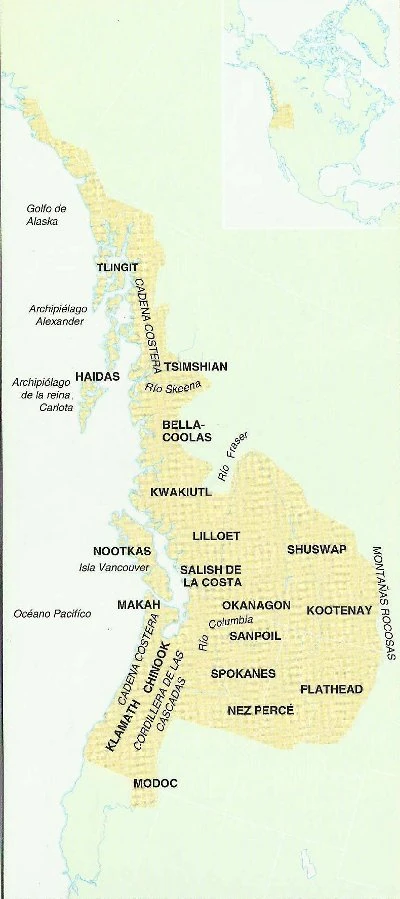


In the northwestern region, natives of the Northwest Coast culture live in communities with spacious wooden houses. Thanks to a mild climate and the availability of abundant food, in particular salmon, they have the ability to devote a considerable amount of time to their rituals. Each clan has as its founding figure a mythical being, symbolized in totemic posts and other objects. Among these mythical beings, the Cuervo, the Ave Trueno and the Spirit Cannibal stand out.
In the archipelago of Queen Carlota, located in British Columbia, is the land of the haids, known as Haida Gwaií, which means "the islands of the people". These are a proud maritime community that gets its wealth from the sea, and in the past, their villages were the most prosperous on the northwest coast. Before the arrival of Europeans in the 1770s, about 7,000 haidas lived in more than 30 coastal villages, consisting of solid houses built with cedar boards. Some settlements were small, while others spread along the coast, covering up to 1.5 km.
Similar to other houses in the northern northwestern region, the haida houses were spacious and rectangular, shared by several related families. These typical dwellings included corner poles, inner poles that held the roof beams, ceilings and cedar floors, all connected by wooden ropes or clavings. There were platforms along the inner walls for sitting and sleeping, with wooden divisions or cedar beams separating the different families.
The social hierarchy was reflected in the disposition of the families in the house, with the boss occupying the most distinguished place, at the far end of the entrance, and the slaves near the door. The traditional houses of the Haidas had a single central home, with few openings apart from the door and the hole in the roof where the smoke went out. Sometimes the door had the shape of a figure carved or painted on the façade or on a totemic poles.
This entry was a reflection of nature similar to a womb of housing. The villages were mainly occupied during the winter, as in the summer, the inhabitants moved to temporary camps to collect food as they developed.
If you looked at a haida village as it was in the 19th century, you would be amazed to see the set of carved cedar poles that rose between the houses of the haida villages. These indigenous peoples had more posts and greater height than any other group on the northwest coast. There were three main types: the totemic post, which showed the emblems of the families living in each house; the commemorative post, erected in honour of the ancestors and to whom tribute was rendered; and the mortuary post, on which the coffin containing the remains of the forefathers was placed.
In the late 19th century, European diseases and governmental and missionary resettlement programmes caused the depopulation and abandonment of many Haida villages.
By 1900, about a thousand surviving haidas were located in Massett and Skidegate, missionary settlements north of Queen Charlotte's archipelago. From 1890, the village of Yan became deserted. In 1991, the descendants of the last inhabitants of Yan gathered in the abandoned village to conduct a ceremony of erection of a new totemic post representing the bear clan. This cedar pole was carved by Jim Hart, a member of the new generation of indigenous artists who, over the past three decades, have dedicated themselves to the resurgence and preservation of the ancient sculpture skills of the northwest coast.
The unfortunately abandoned Haida villages soon deteriorated, as the white settlers cut the carved poles to use them as timber, sent them to museums or let them deteriorate.
 Native American Cultures: Myths and magic
Native American Cultures: Myths and magic
You can purchase this book on Amazon.
This book challenges deep-seated stereotypes and offers an enriching perspective that contributes to a more comprehensive and respectful appreciation of the indigenous peoples of North America. Through an understanding of their myths and beliefs, we are taking an important step toward cultural reconciliation and the recognition of the diversity that has enriched the history of this continent.
These mythical stories, many of them linked to the literary genre of fantasy, reveal a world where the divine and the human intertwine in narratives that explain the cosmic order, creation, and the fundamental structure of the universe. Discover how these sacred tales bear witness to the deep connection of the natives with nature and spirituality.
Native Americans: Population and Territories
Native Americans: Cultures, customs, worldview
Traditions, myths, stories and legends